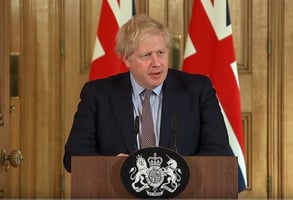Boris Johnson had been criticised for his lack of visible leadership in recent weeks.
The start of 2024 has seen the UK hit by storms and floods.
Hundreds of flood warnings have been in place across the country, people have been evacuated from their homes, and others have been left without power.
But amid the chaos and heartbreak, there have been examples of how smartphone video can be a crucial crisis communication tool.
Environment Agency employees have been doing an excellent job of communicating about the flooding on their personal social media channels and regional corporate accounts.
A video from Marc Lidderth, the agency’s area director for West Midlands, captured my attention.
The region has been particularly hard hit and flood warnings have been in place across the length of the River Severn, from Shrewsbury in Shropshire down to Upton-upon-Severn in Worcestershire.
He posted a video from one of the impacted areas explaining peak river levels and providing advice for people in those areas.
Rainfall over past several days and more today means seeing multiple 'peaks' along the #Severn and #Wye rivers.
— Marc Lidderth (@MarcLidderthEA) January 2, 2024
Our peak maps are produced daily to help advise on when and to what level the rivers will reach.
Keep updated with our warnings - link at end of 👇 pic.twitter.com/5e5xdSbETs
On the Environment Agency’s Midlands X account, there is a video of incident team manager Nick Green discussing flooding in Evesham and offering advice about walking and driving in the conditions.
Sound advice from our Area Incident Team Leader, Nick Green from the #RiverAvon in #Worcestershire
— Env Agency Midlands (@EnvAgencyMids) January 3, 2024
Please heed this warning if you come across #flood water on your journey.
We're seeing impacts from the recent heavy rainfall across the #Midlands
Stay safe and #FloodAware pic.twitter.com/uoN6zLthJX
Just before the New Year, Chris Bainger, another Environment Agency employee, shared a video showing flood barriers going up in Bewdley and gave advice on where people could receive flood alerts.
LIVE: River #Severn #Bewdley #Worcestershire our @EnvAgencyMids operations team adding additional protection to Bewdley #flood ahead of rising river levels.
— Chris Bainger (@ChrisBaingerEA) December 28, 2023
For the latest levels and warnings see here 👇🏻https://t.co/24yt1X6svd pic.twitter.com/JQBPOF8e3y
There are also plenty of images being shared.
Barry Killner, for example, shared pictures of those flood barriers in Bewdley being installed – and then heightened as river levels continued to rise.
The @EnvAgencyMids field team are adding slats to raise the levels of #Severnside demountable barrier in #Bewwdley today @WorcsTravel @WyreForestDC pic.twitter.com/dTJZNfPE49
— Barry Killner (@BarryKillnerEA) January 3, 2024
There’s much to like about this crisis communication approach.
Firstly, it's another way of helping the Environment Agency reach the communities impacted, leaders and local journalists - the more people who share the updates, the wider the information travels.
And it helps keep them updated. Remember, you can’t over-communicate during a crisis.
It also highlights the organisation is taking action to resolve the situation with its people out in the flooded areas. There is a reassurance about seeing Environment Agency officials in the floods working to limit the damage and improve the situation.
And it also brings a human face and warmth to the messaging, making it feel more personal and connected.
In an age where people are seemingly often prepared to argue that black is white, it is harder to argue with someone who is standing in floodwater telling you of the risks of driving through it than it is a corporate account sharing those same messages.
Additionally, the video and pictures are taken on mobile phones, adding realism and authenticity to the content.
One of the other great benefits of this approach is that it is cost-effective.
Virtually all of us have everything we need already in our pockets.
Smartphones not only enable you to capture high-quality 4k footage, but you can also edit it. It is essentially a full video studio.
All you need is a bit of guidance on capturing footage and making it look and sound great through the editing process – something we can help with.
Once that guidance is in place, you potentially have a team of people who can play an active role in your crisis communication and telling positive stories during better times.
Would this approach work for every organisation?
The Environment Agency appears to have a policy encouraging its people to talk about their work and share information on social media.
There are many profiles of people who mention it in their biogs and who share posts from the organisation's national and regional corporate accounts, as well as their own material.
Other organisations looking to do the same would need to take a similar approach, with clear guidance on who can create this content and what they can cover.
There needs to be a strategy and message discipline – you can’t have everyone and anyone making and sharing content.
And they need training. Not just on how to make good quality video, but also on ensuring they communicate naturally, using everyday language and don’t come across like they are reading a script.
Would this work in all forms of crisis media management?
Like a lot of effective crisis media management, where to deploy smartphone video needs planning and consideration in advance.
Don’t think about it for the first time when you are in the spotlight. And there will be some situations like workplace accidents and legal issues where it is unlikely to be appropriate.
A good starting point is to think about the likely causes of a crisis for your organisation, how video could help in those situations and who should make them.
Imagine you work for a company in the energy sector and are managing a major power outage.
How useful would it be for your teams in the field to be able to make and share videos that give customers timely, engaging and understandable updates about the work carried out to restore power?
Merlin Entertainments, which has plenty of time in the crisis spotlight, uses staff video to update people and reassure them about any issues on its rides.
Following media stories reporting the routine stoppage of Oblivion, here is Operations Director Francis Jackson to explain what happened. pic.twitter.com/U0Uo48RF3q
— Alton Towers Resort (@altontowers) July 25, 2017
Could your organisation use them to communicate service disruption, product issues or technology failures?
Smartphone videos are versatile. As well as using them to communicate on social media, you could also embed them on your website and use them in your internal communication.
So, is it time you added smartphone video to your crisis communication toolkit?
Media First are media and communications training specialists with more than 35 years of experience.
We have a team of trainers, each with decades of experience working as journalists, presenters, communications coaches and media trainers.
Click here to find out more about our crisis communication training courses.




